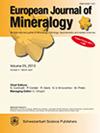Pseudo-cubic trigonal pyrite from the Madan Pb–Zn ore field (Rhodope Massif, Bulgaria): morphology and twinning
IF 1.7
3区 地球科学
Q2 MINERALOGY
引用次数: 0
Abstract
Abstract. A new occurrence of pyrite crystals with rhombohedral habit, up to several centimeters in length, is described from the Madan Pb–Zn ore field (Rhodope Massif, south Bulgaria), where it constitutes a late pyrite generation. As observed in the past in other deposits, the ideal rhombohedron is derived from the pyritohedron by suppression of half of its faces (six “polar faces”) around a ternary axis. In studied crystals, together with six main “equatorial faces”, additional minor faces correspond to cube faces as well as polar faces. Such a dissymmetry indicates that the crystallographic point group of these crystals is 3‾, a subgroup of the eigensymmetry 3‾2/m of a rhombohedron taken as geometric face form. Twinning by metric merohedry confirms such a symmetry decrease and permits the definition of this type of pyrite as a dimorph of cubic pyrite, i.e., pseudo-cubic trigonal pyrite (pyrite-R). Twin operations belong to the set of symmetry operations absent in point group 3‾ relative to pyrite symmetry m3‾: reflection about the {100} plane or two-fold rotation about the <100> direction. Four twin types have been distinguished (name, chromatic point group): three contact twins (reflection, m′; rotation, 2′; trapezoidal, (m(2)m(2)2(2))(4)), as well as one penetration twin (crossed, 2′/m′). Composition planes always correspond to {100}, but there are two types of twin interfaces. More complex twinned samples may develop erratically during crystal growth. Other twin variations as well as genetic aspects of such a type of pyrite are discussed.马丹铅锌矿区(保加利亚罗多佩地块)的拟立方三角黄铁矿:形态和孪晶
摘要在Madan Pb-Znore矿区(保加利亚南部Rhodope地块)发现了一种新的黄铁矿晶体,其长可达几厘米,构成了黄铁矿的晚期。正如过去在其他矿床中观察到的那样,理想菱形体是由pyritohedron通过抑制其围绕三元轴的一半面(六个“极面”)而得到的。在所研究的晶体中,除了六个主要的“赤道面”外,还有其他的小面对立方体面和极面有反应。这样的不对称性表明这些晶体的结晶点群是3的,是一个以几何面形为菱形的本征对称3的2/m的子群。用米制墨变法孪生证实了这种不对称性的减少,并允许将这种类型的黄铁矿定义为立方黄铁矿的二晶型,即伪立方三角黄铁矿(黄铁矿- r)。孪生操作属于点群3中不存在的对称操作的集合,相对于黄铁矿对称m3,关于{100}平面的反射或关于方向的二次旋转。已区分出四种孪生类型(名称,色点群):三种接触孪生类型(反射,m ';旋转,2 ';梯形,(m(2)m(2)2(2))(4)),以及一个穿透双胞胎(交叉,2 ' /m ')。组合平面总是对应{100},但是有两种类型的孪生接口。在晶体生长过程中,更复杂的孪晶样品可能不规律地发育。讨论了这种类型黄铁矿的其他双胞胎变异以及遗传方面的问题。
本文章由计算机程序翻译,如有差异,请以英文原文为准。
求助全文
约1分钟内获得全文
求助全文
来源期刊
CiteScore
2.80
自引率
9.50%
发文量
40
审稿时长
6-12 weeks
期刊介绍:
EJM was founded to reach a large audience on an international scale and also for achieving closer cooperation of European countries in the publication of scientific results. The founding societies have set themselves the task of publishing a journal of the highest standard open to all scientists performing mineralogical research in the widest sense of the term, all over the world. Contributions will therefore be published primarily in English.
EJM publishes original papers, review articles and letters dealing with the mineralogical sciences s.l., primarily mineralogy, petrology, geochemistry, crystallography and ore deposits, but also biomineralogy, environmental, applied and technical mineralogy. Nevertheless, papers in any related field, including cultural heritage, will be considered.

 求助内容:
求助内容: 应助结果提醒方式:
应助结果提醒方式:


